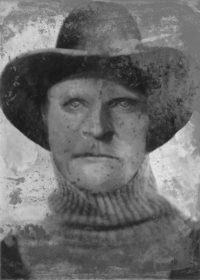 A torso and scattered remains found in an Idaho cave in 1979 has been identified as Joseph Henry Loveless, bootlegger, counterfeiter and murderer who escaped from jail in 1916 and was never seen again.
A torso and scattered remains found in an Idaho cave in 1979 has been identified as Joseph Henry Loveless, bootlegger, counterfeiter and murderer who escaped from jail in 1916 and was never seen again.
As reported in the May 12, 1916, edition of The Idaho Republican, the butchered remains of Mrs. Charles Smith were discovered the morning of May 6th, “the head hacked to pieces with an axe” in a tent outside Dubois. The bloody weapon was found by her side. Her husband was immediately suspected.
He something of a drifter, doing odd jobs around the Dubois railroads. In the press he was described as about 40 years old, 5’10”, weighing about 180 lbs. The only distinguishing feature mentioned was actually the lack of one: he apparently had no eyebrows.
He was captured on May 7th and held in St. Anthony, Idaho, charged with murder. He claimed that her former husband had killed her and that he was heading north for whiskey that his wife would then sell in Dubois. He told other tall tales as well, and pinpointing his real name and the nature of their relationship proved troublesome. After the Charles Smith alias fell by the wayside, he was variously identified as Walter Cairins and Water Curran. Then the woman he’d said was his wife was identified as Mrs. Agnes Loveless, wife of Henry Loveless, and therefore his common-law wife at best.
Finally his identity was conclusively determined by his son. He was Joseph Henry Loveless, born to Mormon settlers in Utah in 1870. He would become a career criminal, making a living counterfeiting money and running liquor through Idaho’s dry counties. He was also suspected of having murdered rancher Joseph C. Smith in Pebble, Idaho, for money the year before his wife’s murder.
Loveless had been arrested numerous times, and kept a saw in his shoe to break out of jails. In fact, when his son identified him to the authorities, he warned them that his father would escape jail. He broke out of St. Anthony jail on May 18th, and that was the last anyone heard of him.
In 1979, a family looking for arrowheads in a cave found a torso wrapped in burlap. In 1991, more body parts — a hand, an arm, two legs –were found in the same cave. The arm and legs were also wrapped in the same burlap.
Over the years, attempts by law enforcement and researchers to identify the remains came up short. All they were able to conclude was that the man had been white with reddish-brown hair and around 40 years old.
Then in 2019, the sheriff’s office asked for help from the DNA Doe Project, a nonprofit that uses the latest DNA technology to identify remains.
Within four months, the mystery was solved. The DNA Doe Project obtained a detailed DNA sequence from a lab in Texas, built a genealogical tree and located a living grandson of Loveless whose DNA matched perfectly.
“It’s blown everyone’s minds,” forensic genealogist Lee Bingham Redgrave said at a news conference Tuesday. “The really cool thing, though, is that his ‘wanted’ poster from his last escape is described as wearing the same clothing that he was found in, so that leads us to put his death date at likely 1916.”
His head is still missing, which may be a clue to the motivation for his murder. He had chopped his wife’s head off, and shortly thereafter someone chopped off his. A little frontier justice, perhaps?